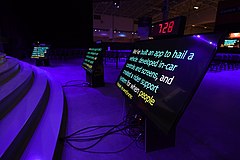Teleprompter
A teleprompter, also known as an autocue, is a display device that prompts the person speaking with an electronic visual text of a speech or script.
For the racehorse, see Teleprompter (horse).
Using a teleprompter is similar to using cue cards. The screen is in front of, and usually below, the lens of a professional video camera, and the words on the screen are reflected to the eyes of the presenter using a sheet of clear glass or other beam splitter, so that they are read by looking directly at the lens position, but are not imaged by the lens. Light from the performer passes through the front side of the glass into the lens, while a shroud surrounding the lens and the back side of the glass prevents unwanted light from entering the lens. Optically this works in a very similar way to the Pepper's ghost illusion from classic theatre: an image viewable from one angle but not another.
Because the speaker can look straight at the lens while reading the script, the teleprompter creates the illusion that the speaker has memorized the speech or is speaking spontaneously, looking directly into the camera lens. Notes or cue cards, on the other hand, require the presenter to look at them instead of at the lens, which can cause the speaker to appear distracted, depending on the degree of deflection from the natural line of sight to the camera lens, and how long the speaker needs to glance away to glean the next speaking point; speakers who can internalize a full sentence or paragraph in a single short glance timed to natural breaks in the spoken cadence will create only a small or negligible impression of distraction.
The technology has continued to develop, including the following iterations:
'TelePrompTer' in the US, and 'Autocue' in Commonwealth and some European countries, were originally trade names, but have become genericized trademarks used for any such display device.
The word "TelePrompTer", with internal capitalization, originated as a trade name used by the TelePrompTer Corporation, which first developed the device in the 1950s. The word "teleprompter", with no capitalization, has become a genericized trademark, because it is used to refer to similar systems manufactured by many different companies. Some other common terms for this type of device are:
Various types of modern teleprompters








